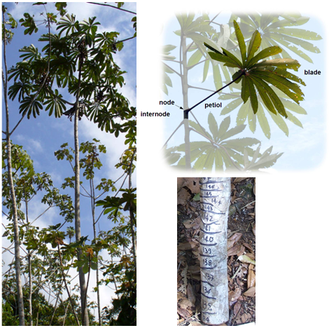Preliminary Course
Applied Mathematics
Probabilities. Some Usefull probability Laws
Bernoulli trials
A first introductive example
The most famous example of a Bernoulli process is that of successive tosses of a balanced coin.
On the question did the coin land heads?, we can define p as a probability of success and q as a probability of failure.
For a fair coin, we have p = q =1/2.
A second example
A probabilistic view of plant development consists in considering that stems elongate by the successive addition of some basic units called phytomers.
Assume that a stem has a probability 0.8 to set in place a phytomer every month.
Therefore, every month, the stem can either produce a new phytomer (success event) or be in pause (failure).
The appearance of a phytomer thus follows a Bernoulli process with the probability of success being p = 0.8.

A new phytomer apparition seen as a Probability of success event (Drawing V. Letort-Lechevalier)
Left scenario: the success case (with a probability 0.8 to occur); a new phytomer appears
Right scenario: the failure case (with a probability 0.2 to occur); no new phytomer appears, the terminal bud rests
Definition.
Repeated independent trials are called Bernoulli trials if there are only two possible outcomes for each trial and their probabilities remain the same throughout the trials.
The sample space of each individual trial is formed by the two possible outcomes, which are usually referred to as S (Success) and F (Failure).
The sample space of n Bernoulli trials contains 2n points or successions of n symbols S and F, each representing one possible outcome of the compound experiment.
If the probability of Success is denoted as p, then the probability of failure is obviously q = 1 - p.
The probability of any specified sequence {S, F, F, F, S} is the product of the corresponding probabilities, pqqqp = p2(1-p)3.
Exercises
-
Cecropia is one of the most emblematic pioneer genera in the Neotropics.
These species are able to colonise cleared areas with high light levels, in particular after disturbances, and are thus essential contributors to the regeneration of mature forests.
|
Assume that young Cecropia sciadophylla have a probability p = 0.6 to set in place
a phytomer every two weeks. Let us note 'M' the event phytomer appearance and 'P' for a pause in the development.
2. Successive Bernoulli trials are hold with success ('M') probability p = 0.8 Which ones of the following sequences are generated with probability 0.1024 ? |
 Cecropia sciadophylla (Photos P. Heuret, INRA) Left: global view. Right, top, a phytomer. Right bottom: counting internodes on a stem section. |
Definition
Metamer (Phytomer)
Botany. Botanical entity formed by a node, associated with its leaf (or leaves) and axillary bud(s) plus the subtending internode. First defined by White, 1979.Definition
